Looking for a go-everywhere canine but in a compact size? If so, then the Norfolk terrier is one you need to adopt. Terriers of all types, let alone Norfolk terriers, love games and adventures, and despite their soft and fragile bodies, they hold an insane amount of energy, packed within them!
That’s why Norfolk terriers are considered the most miniature working terriers out there. Originally bred to hunt rodents and foxes, this working terrier is still used for the same cause, in various regions of the world.
However, many people think that these small terriers might also serve as great lapdogs, but that’s not the case. Due to a high prey drive, ultra-curious nature, and insane need for interactions, you can never make a Norfolk terrier sit peacefully for more than an hour.
But still, they make an excellent choice as a family pet, even if the family has a super small yard. Considering this vast range of shades the personality of the Norfolk terrier dog breed holds, today we’re going to discuss this breed in detail – including its history, temperament, appearance, health, care, and fun facts.
So just keep reading the article to know whether this earth dog is worth all the hype or not! Let’s begin!
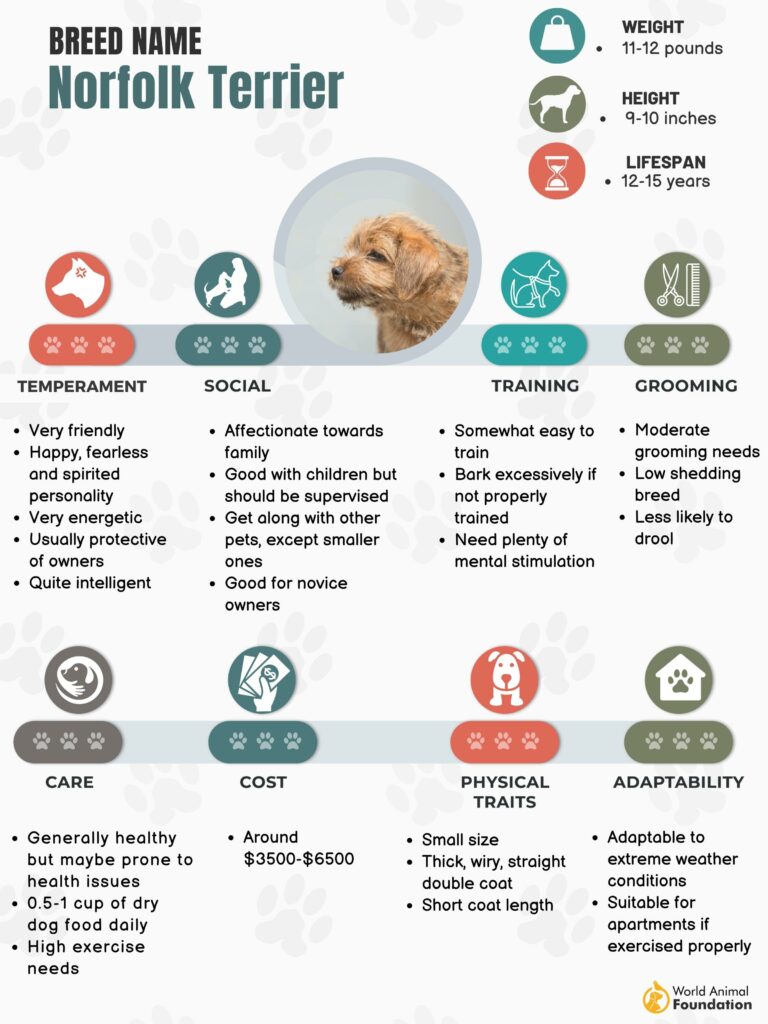
About the Breed
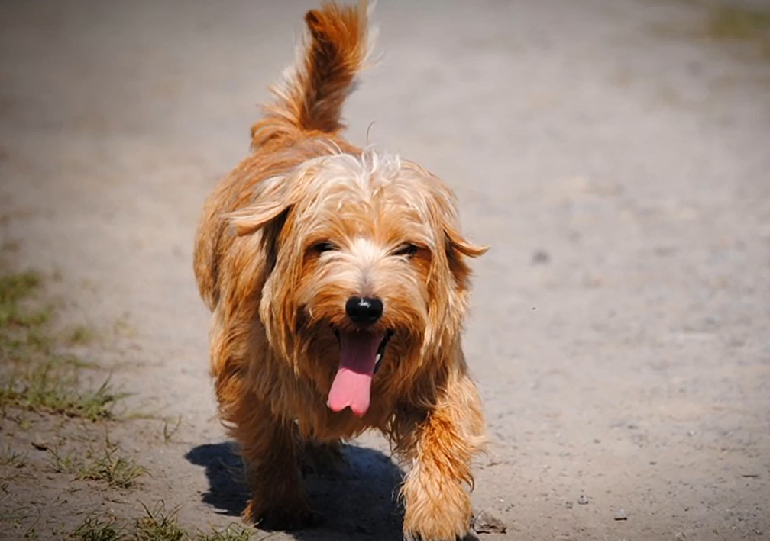
At first glance, Norfolk terriers look toyish but don’t let their small size fool you. They pack all the golden qualities of terriers, including impeccable confidence, remarkable intelligence, and hilarious curiosity.
Speaking generally of their appearance, they resemble closely to their cousin, Norwich terriers, having only one distinction; Norfolk terrier has floppy ears whereas the Norwich terrier has pointed ears.
Although Norfolk terriers don’t have much problem curling up to your lap for cuddles, you shouldn’t expect them to behave like couch potatoes.
However, if your Norfolk dog doesn’t cuddle with you, it doesn’t mean that he doesn’t love you. All you need to understand is that his way of expressing love is different. He’d prefer to play outside with you or join you in your daily walks. Due to their small size, they don’t need a wide yard to vent their energies out.
Likewise, the Norfolk terrier makes a superbly portable and loyal companion to travel with. Although with their toyish size and fragile jaws, they are not much impressive as guard dogs, still, with their low-pitched, sky-shattering barks, they serve as excellent watchdogs.
History of the Norfolk Terrier
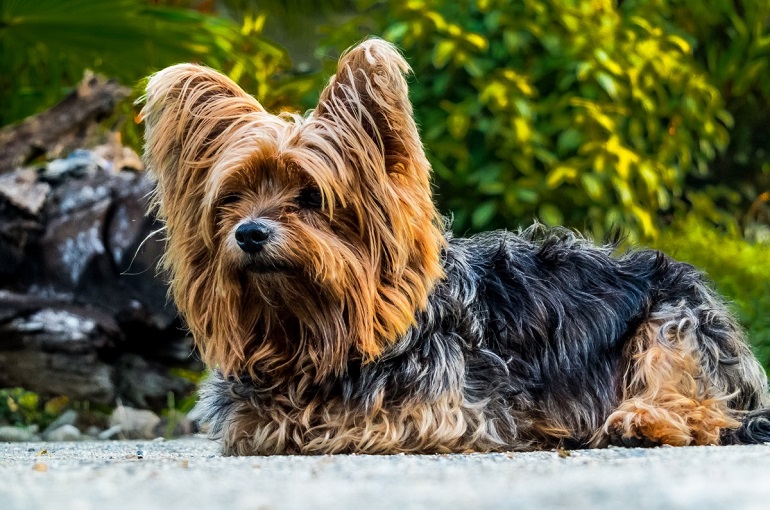
Norfolk terriers belong to the British class of canines and were considered a variety of Norwich terriers till 1964. Before that, both the Norfolk and Norwich terriers were categorized as the same breed.
Both breeds were shown up in 1800 and are believed to be developed by the cross of Cairn terriers, Irish terriers, and border terriers. However, at the start of the 19th century, students of Cambridge University began to complain about the increasing rat population, for which, they started to use little terriers as hunters.
These miniature terriers were first called the Cantab terriers and later, they got famous by a new name; Trumpington terriers. The breed got its later name after the address of its very first breeder, Jodrell Hopkins who used to have a livery stable at Trumpington street.
Since the demand for small rodent hunter dogs was increasing, with the increase in the rat population, Hopkin extended the breeding program of small terriers, with the help of another Cambridge canine dealer; Doggy Lawrence.
The very first man who gave this breed its original name; Norwich, was Frank Jones. Terriers of that time, which were used in breeding programs were called rags. Jone’s boss received rags from Hopkins and started his breeding with many other dog breeds, to produce something more desirable.
In the meantime, another hunter terrier appeared, with prick ears and smooth coats named ninety. An English dog breeder bred Rag with Ninety as a result of which, various little red pups were produced. Jones brought all of these pups, left the employment, and took their breeding to a higher level.
Not only this, but Jones also began to sell these small red pups under his name, after which, these dogs were called Jones terriers, in America. Another breeder jumped into the field, bought a rag dog, and bred it with multiple dogs including Irish terriers, Bedlington terriers, and Staffordshire terriers.
Finally, in 1929, he succeeded to produce the smallest terrier, with a harsh coat, short legs, dark eyes, and an energetic personality. The Norfolk and Norwich terriers, we know today, are believed to be the descendant of these smallest terriers.
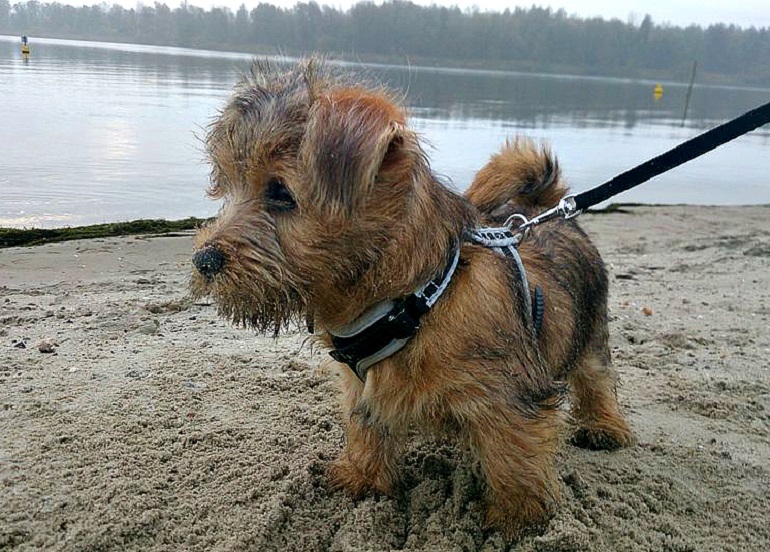
This breed was officially recognized by America and Britain in 1930, as the same breed but the English Kennel Club refused to classify pricked-eared and drop ears dogs into the same category.
Even after both ear types were recognized by the English Kennel Club, a debate about setting breed standards rose. Many breeders of that time insisted to set terriers with erected ears as standard, whereas some other breeders wanted to see dogs with drop ears as a standard.
When no one won the debate, breeders launched interbreeding programs where they set both dogs as the breed standard and started to breed pricked-ear dogs with drop-eared ones. As a result of this interbreeding, the problem of ear carriage rose after which, breeders realized what a terrible mistake they’d made.
Thus, right after World War II, breeders stopped interbreeding, and the England Kennel Club finally separated pricked ears terriers from drop-eared ones, in 1964. Today, the drop ears terriers are called Norfolk terriers whereas the pricked ear dogs are called Norwich terriers.
In 1979, the American Kennel Club also recognized Norfolk terriers as a separate breed from other terriers. Although the present-day Norfolk terrier is here as a result of the restless efforts of responsible breeders, this dog breed has the most versatile personality, which is further embellished by the golden traits of its ancestors.
That’s another reason why Norfolk terriers are the most desirable and appealing terriers out there.
Norfolk Terrier Facts
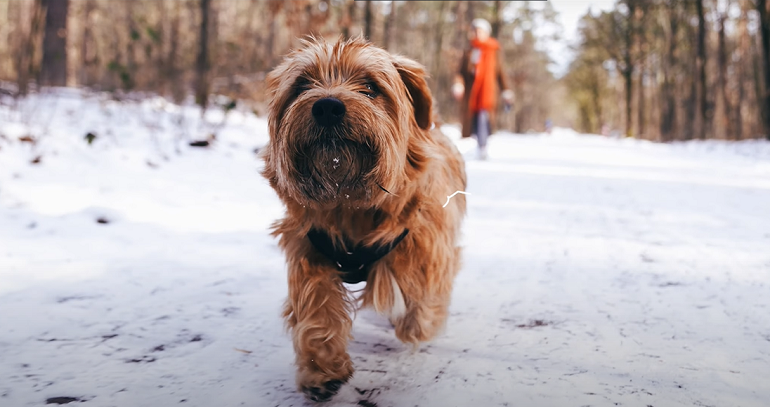
- Since the breeding and grooming procedures of Norfolk terriers are super costly, they are one of the rarest dogs in America. According to the estimate given by the American Kennel Club, only about three hundred Norfolk terriers are born in the entire America, every year.
- Norfolk terriers can live almost everywhere (in an apartment, farm, house, etc) as long as it has a small yard where they can run and play around freely.
- Although the Norfolk terriers, sometimes, get jealous, they are great as family pets. They are generally friendly if socialized and trained properly. They can even bond closely with other dogs and cats of the family if raised along with them.
- When proper diet, mental stimulation, and physical activity is provided, the life expectancy of a typical terrier is 12-17 years.
- Norfolk terriers can reproduce, naturally, after reaching the age of one year. Their gestation period is of 60-80 days whereas, in one litter, about 2-4 puppies are born.
- When left for too long periods, Norfolk terrier dogs tend to develop separation anxiety. In this condition, these dogs make special guttural sounds – one of the special traits of Norfolks.
- If you are allergic to fur and drools, then look no further since Norfolk terriers come with the lowest tendencies to drool and shed.
- Due to being the rarest terrier, Norfolk terrier may cost around $2100-$6500.
- Since their coat is not too dense or long, they prefer to stay inside the house, especially during winter.
- Since they are super curious, Norfolk terriers tend to dart off or distract, quite easily. Therefore, you better never leave them off-leash, outside the house.
Norfolk Terrier Appearance
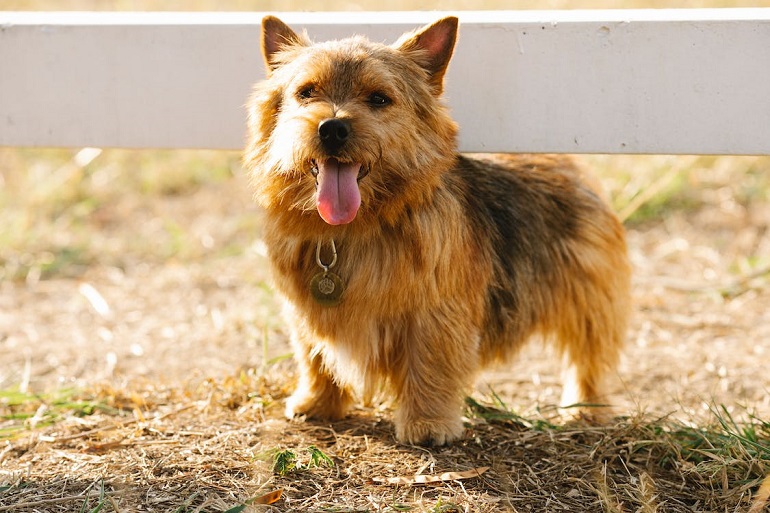
There are only three words that one may use to describe Norfolk terriers; cute, cuter, and cutest. Everything about these small, fierce canines is adorable, from their aww-mazing short legs to sparkling, dark eyes to docked tails.
In addition to this, the dogs of this breed possess well-defined eyebrows and whiskers, with a small, fox-like, wedge-shaped muzzle. Their floppy ears hang close to the eyes and with a tight-lipped expressions, they look both serious and sweet, at the same time.
Size
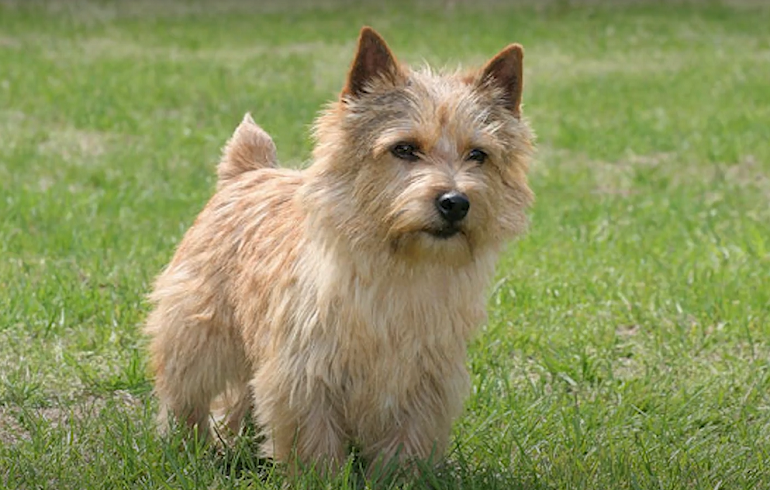
Norfolk terriers fall under the category of small pets. Both their males and females possess small stature of about 11-12 inches from the shoulder. However, sometimes, female terriers grow only to nine inches.
Weight
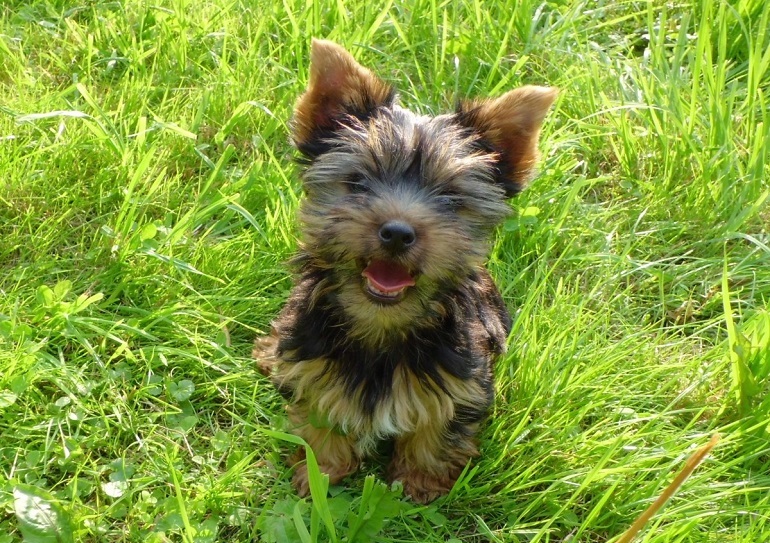
Since they have a small size, they usually weigh around 11-12 lbs. However, it’s only true for healthy dogs. Norfolk terriers with unhealthy diets and improper exercise routines tend to weigh even heavier.
Coat
One of the most distinctive features of Norfolk terriers is their double coat, which feels both harsh and smooth, on different parts. Around the neck and shoulders, the wiry coat is rough and long whereas around the head, abdomen, and ears, the coat is small and smooth.
Generally, the outercoat is hard, to save the animal from damaging elements whereas the soft undercoat is there to keep the pooch at utmost comfort.
However, both these coats work together to provide enough insulation against extreme cold and hot environments, making them weather resistant. Also, both coats might be 1.5-2 inches long.
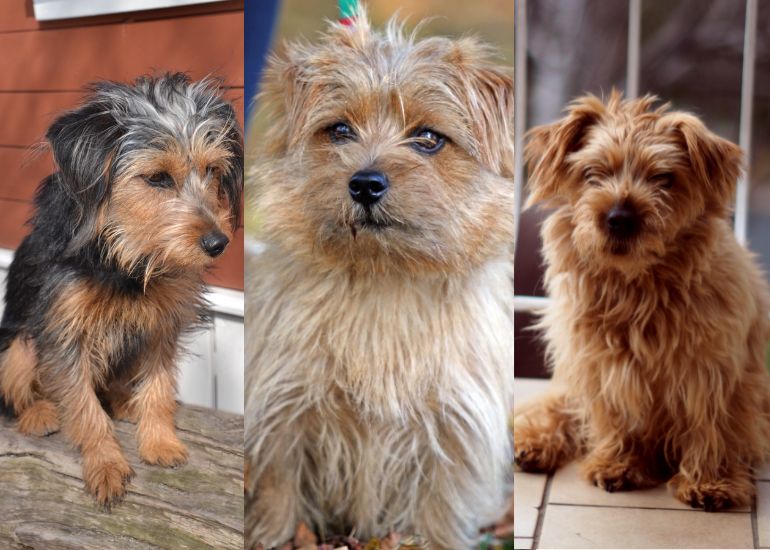
Color
Generally the Norfolk coat colors, one may get to find are wheaten black, and tan. In addition to these, colors like red, grizzle, black, and tan are also common. Occasionally, Norfolk terriers tend to come with or without white markings and dark points.
Norfolk Terrier Temperament and Personality
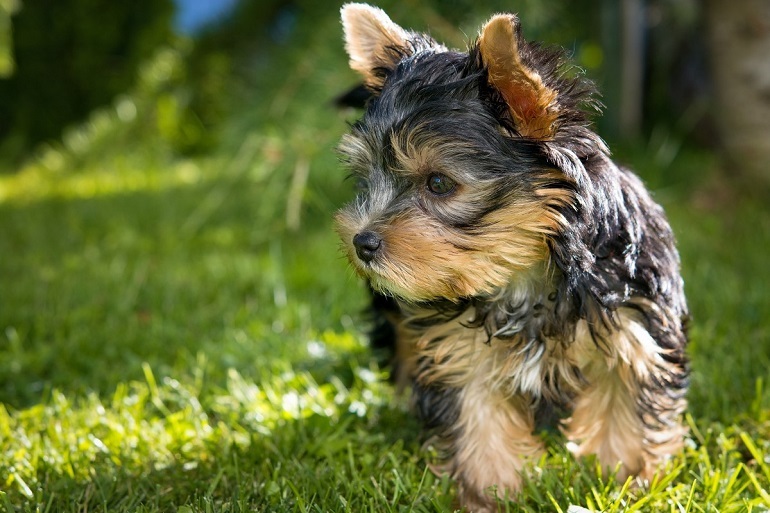
Norfolk terriers are super affectionate and love everyone – From their human family members to other family pets to even your neighbors.
Mostly, they tend to behave gently around children but still, they might or might not have some degree of quarrelsomeness. Therefore, it’s better to supervise when these smallest terriers are playing with your kids.
Although their exercise needs are insane, due to their compact size, you can arrange dog sports for them, even in your small fenced yard. Due to their high ratting instincts, they tend to enjoy almost every game that involves chasing or tossing around.
The best part is that you won’t need to spend a hefty fraction of your hard-earned wages to buy costly sports gear or fancy toys. These Norfolk terriers can play happily with anything like bones, sticks, balls, marble, etc.
However, you still shouldn’t leave them all alone in your backyard since this may trigger undesirable traits in them, like excessive barking and digging.
Most of the time, Norfolk terriers tend to stay friendly with other pets of your family but still, they should never be left alone with smaller animals like hamsters, guinea pigs, mice, pet rats, etc.
Wondering why? Well because Norfolks, due to sharing a hunter lineage, tend to have a strong urge to kill smaller animals and birds. Similarly, if not trained properly, they might turn out to be super stubborn and great leash pullers.
Besides these undesirable habits, they may also develop small dog syndrome, which may lead to a wide range of other behavioral problems, including jealousy, separation anxiety, and guarding temperament. If raised to the extreme level, this syndrome may turn your dog insane they will do everything in their power to break the house.
Care and Health Norfolk Terriers
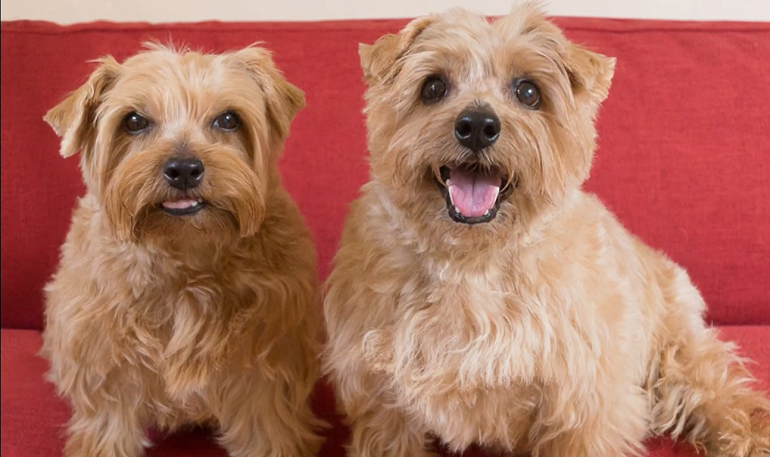
Like other purebred dog breeds, Norfolk terriers are also generally healthy but still, they might develop some severe health issues including eye problems and severe back aches. Besides, some Norfolk terriers also show up some genetic problems as follows;
Patellar Luxation
This condition is often caused due to a high need for the activity that these Norfolk terriers possess. In this, the kneecap of a dog is displaced, which in turn causes severe pain and abrasion, whenever the joint moves.
The joint continues to slide in and out of its original position, which not only keeps your dog in discomfort but also limits mobility. If not severe, a dog may live a completely normal life but after getting worse, it might have to undergo knee surgery.
However, even after surgery, the condition can show up over and over again, throughout the lifespan of your little terrier.
Hip Dysplasia
Hip dysplasia is a genetic disorder that may transmit from one generation to another. In this, the mobility of the rear legs gets affected since the femur hangs loosely in the pelvic socket.
Resultantly, your canine might have to suffer from severe pain and fatigue. Even if such a dog is bred, odds are high that its offspring are more likely to develop the same disorders. Therefore, before adopting a Norfolk terrier, it’s advised to ask the breeder to show a health clearance certificate issued by the orthopedic foundation.
Mitral Valve Disease
This health condition affects the proper functioning of the heart, causing a heart murmur. Resultantly, the efficiency of the blood circulatory system and heart reduce terribly, decreasing the blood flow rate to a dangerous level.
Vaccination Sensitivity
As the name implies, this health condition involves body reactions that a canine has to suffer after getting routine vaccinations. Right after getting vaccinated, your dog’s body may react in various ways in the form of soreness, lethargy, facial swelling, hives, etc.
Some dogs may even die from a strong dosage of vaccination so you better keep your vet posted about any unusual symptoms you may witness in your healthy Norfolk terriers.
Besides these disorders, Norfolk terriers are highly prone to getting obese therefore you better adhere strictly to the diet plan, recommended by your vet and don’t fall for those puppy eyes, begging for just one more treat.
Generally, vets recommend a diet specifically for your dog after considering various factors, including his metabolism, size, activity, and build. Still, it’s advised not to feed more than one cup of dried dog food a day, to a Norfolk terrier.
Speaking of their exercise needs, a playtime of around 30-40 minutes is enough. A fenced yard is well suited to these dogs’ temperament unless they are not suffering from boredom or separation anxiety. In another case, they might become a hassle to your neighbors by their unstoppable barking and digging.
Since their coat is neither too short nor too long, it comes with moderate grooming needs. You better brush the hair once or twice a week to prevent matting or tangling. Brushing will also remove debris from the coat.
Likewise, they shed their coats minimally but still, you should remove the shedding hair by hand strip method. Their floppy ears are more prone to develop infections, if not cleaned properly so don’t forget to clean them every week.
To save these dogs from gum diseases and toothaches, brush their teeth using special dog toothpaste. However, you should strictly avoid overbathing since doing so may strip off the natural oil from their coat and skin.
Norfolk Terrier Training
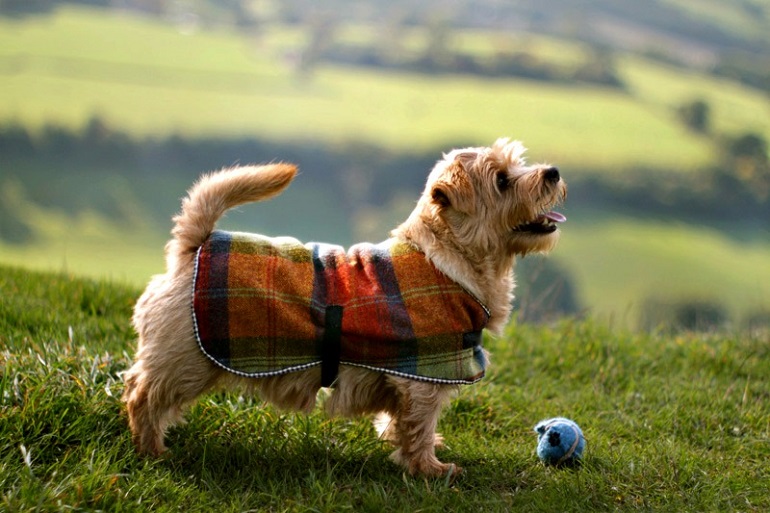
Like other breeds who have a high prey drive and remarkable energy levels, Norfolk terriers should be trained from a very young age. Since you are starting to work on their behavior from puppy age, never think of using negative reinforcement methods ever.
Norfolk terriers are super smart and can learn things super quickly. It doesn’t matter how stubborn your Norfolk pup is, stay religiously consistent about his training, and don’t forget to reward him with his favorite treat, and you’ll get your well-mannered small terrier in a few days.
Start with agility, socialization, discipline, and obedience training so you won’t have to face tough times later on. Thankfully, it’s super easy to potty train this dog breed since they develop habits very quickly.
To mitigate the process further, you can get help from viable products like odor sprays which are designed specifically to attract canines. Resultantly, the dog will associate the scent with the location of poop.
Likewise, training your dog to sleep at a certain spot is also super easy since all you need to do is to get a crate and make him sleep in the locked crate for a few days. This method won’t only make your dog develop desirable sleeping habits but also teach them bladder control.
The only thing for which you might need professional help is to train your pup to walk on a dog leash. Due to their strong hunting instincts, you’ll have a tough time preventing your dog from darting off.
Conclusion
By now, we’ve discussed almost everything about Norfolk terriers however there are still some things we’d like you to know about this dog breed.
Remember that Norfolk terrier craves attention and can do everything, in their power, to win it. So, before adopting it, you better make sure that you’ll be able to give him enough time.
To keep them physically, emotionally, and mentally healthy, all you need to do is to pay special attention to their diet, exercise, and grooming.
Since Norfolk terriers were bred to hunt in packs, they consider you, your family, and other family pets, as a part of their pack, filling your life with their irresistible charm and hilarious acts – no dull moment around a Norfolk terrier!












